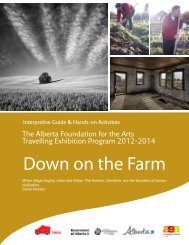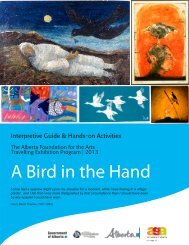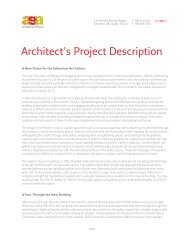Urban Animals - Art Gallery of Alberta
Urban Animals - Art Gallery of Alberta
Urban Animals - Art Gallery of Alberta
Create successful ePaper yourself
Turn your PDF publications into a flip-book with our unique Google optimized e-Paper software.
The <strong>Alberta</strong> Foundation for the <strong>Art</strong>s Travelling Exhibition Program<br />
Animal Studies: Moose<br />
The moose (North America) or European elk<br />
(Europe) is the largest living species in the<br />
deer family. The word moose is a borrowing<br />
from one Algonquian language, with the possible<br />
meaning <strong>of</strong> ‘stripping <strong>of</strong>f’. The word moose first<br />
entered the English language in 1606 with<br />
Captain Thomas Hanham’s Mus. European rock<br />
drawings and cave paintings reveal that moose<br />
have been hunted since the Stone Age.<br />
Excavations in Sweden have yeilded elk antlers<br />
from 6,000 B.C.<br />
Jason Carter<br />
The Moose, 2012<br />
Acrylic on canvas<br />
Collection <strong>of</strong> the artist<br />
In North America the moose range<br />
includes almost all <strong>of</strong> Canada, most <strong>of</strong><br />
central and western Alaska, and much <strong>of</strong><br />
the eastern United States. Isolated moose<br />
populations have been verified as far south<br />
as the mountains <strong>of</strong> Utah and Colorado. In<br />
Europe moose are found in large numbers<br />
throughout the Eastern European nations<br />
<strong>of</strong> Norway, Sweden, Finland and the Baltic<br />
States. They are also widespread in Russia<br />
and can be found in Poland, Belarus and the<br />
Czech Republic.<br />
One <strong>of</strong> the most distinguishing features <strong>of</strong> the<br />
moose are its antlers. The male’s antlers grow as<br />
cylindrical beams projecting on each side <strong>of</strong> the head<br />
at right angles to the midline <strong>of</strong> the skull, and then fork.<br />
The male will drop its antlers after the mating season<br />
and conserve energy for the winter. A new set <strong>of</strong><br />
antlers will then regrow in the spring. Antlers take three<br />
to five months to fully develop. They initially have a<br />
layer <strong>of</strong> skin, called ‘velvet’, which is shed once the<br />
antlers become fully grown.<br />
AFA Travelling Exhibition Program, Edmonton, AB. Ph: 780.428.3830 Fax: 780.421.0479<br />
youraga.ca

















